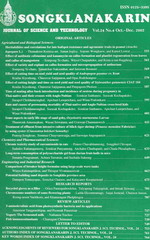ThaiScience
ThaiScience
SONGKLANAKARIN JOURNAL OF SCIENCE & TECHNOLOGY
Volume 42, No. 03, Month MAY, Year 2020, Pages 705 - 713
Optimization of surface roughness and microhardness using the taguchi method in conventional and ultrasonic-assisted milling of aluminum a356
Sed Udomboonyanupap, Somsak Siwadamrongpong, Apiwat Muttamara, Thongchai Pangjundee
Abstract Download PDF
The Taguchi method and regression analysis were used to evaluate the machinability of aluminum A356 with conventional and ultrasonic-assisted milling. Experiments were carried out based on an orthogonal array L18 with three parameters (milling condition, spindle speed, and feed rate). According to the signal to noise ratio (S/N), the optimal surface roughness condition was determined at A1B3C1 (i.e., milling condition was conventional milling, spindle speed was 7000 rpm, and feed rate was 50 m/min). The optimal surface hardness condition was found at A2B1C3 (i.e., milling condition was ultrasonic-assisted milling, spindle speed was 3000 rpm, and feed rate was 400 m/min). Analysis of variance (ANOVA) was used to determine the effects of the machining parameters which showed that the feed rate was the main factor affecting surface roughness and microhardness. Linear and quadratic regression analyses were applied to predict the outcomes of the experiment. The predicted and measured values of surface hardness were close to each other while a large error was observed for the surface roughness prediction. Confirmation test results showed that the Taguchi method was successful in optimizing the machining parameters for minimum surface roughness and maximum microhardness in the milling of aluminum A365.
Keywords
ultrasonic-assisted milling, surface roughness, microhardness, Taguchi method, analysis of varianceSONGKLANAKARIN JOURNAL OF SCIENCE & TECHNOLOGY
Published by : Prince of Songkla University
Contributions welcome at : http://rdo.psu.ac.th
